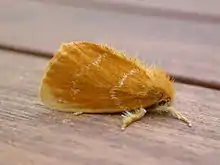Euproctis lutea
Euproctis lutea, the fresh-water mangrove itchy caterpillar,[1] is a species of moth of the family Erebidae. It is found in northern Australia (the Northern Territory, Queensland and New South Wales) and New Guinea.
| Euproctis lutea | |
|---|---|
 | |
 | |
| Scientific classification | |
| Domain: | Eukaryota |
| Kingdom: | Animalia |
| Phylum: | Arthropoda |
| Class: | Insecta |
| Order: | Lepidoptera |
| Superfamily: | Noctuoidea |
| Family: | Erebidae |
| Genus: | Euproctis |
| Species: | E. lutea |
| Binomial name | |
| Euproctis lutea (Fabricius, 1775) | |
| Synonyms | |
| |
The wingspan of the adult moth is about 30 mm. The forewings are yellow with two faint zigzag lines, while the hindwings are plain yellow.[2]
The larvae feed on Lycopersicon esculentum, Begonia species, Myosotis arvensis, Rosa odorata, Barringtonia acutangula and Planchonia careya. They are black and hairy, with a wide white line running along the length of the abdomen, and a wide white spot on the thorax. Full-grown larvae reach a length of about 15 mm, and their hairs can lead to intense itching after contact with human skin. Pupation takes place in a sparse cocoon in a sheltered location away from the food plant.
The moth was first described in European scientific literature by Johan Christian Fabricius in 1775.[3]
References
- "Stinging and Itchy Caterpillars in the Top End of the Northern Territory". (February 2010). Northern Territory Government. Retrieved 27 March 2020.
- Herbison-Evans, Don & Crossley, Stella (31 October 2018). "Euproctis lutea (Fabricius, 1775)". Australian Caterpillars and their Butterflies and Moths. Retrieved 27 March 2020.
- "Species Euproctis lutea (Fabricius, 1775)". Australian Faunal Directory. Archived 5 April 2011.